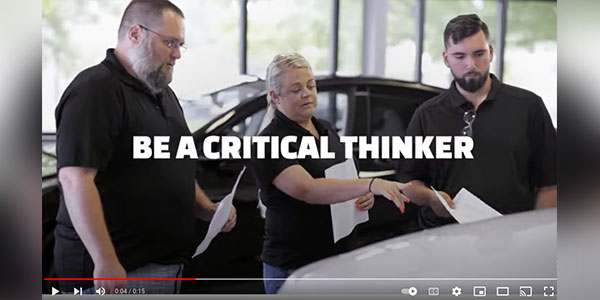If you’re struggling with service revenue, CSI or profitability, the data I’m about to share with you will help you understand what could be causing your pain and hurting not only your fixed operations business but also your entire dealership.
Using our own service BDC evaluation, we compiled the major statistics from 80 service audits. We analyzed 80 dealers operating service BDCs to measure the impact they were having not only on fixed operations but also on key impact areas every dealer values most: retention, CSI, revenue and profitability.
During our evaluation we:
• Listened to more than 30,000 inbound calls
• Spent more than 3,000 hours compiling and analyzing data
• Graded more than 2,400 inbound service-appointment calls
• Reviewed more than 150 surveys from FODs, service managers and BDC managers
• Conducted and scored 80 online mystery-shop appointments
• Conducted 500 mystery-shop calls on brakes, 30K, 90K, tires and more
• Graded 800 price shoppers and the success/fail rates of converting these opportunities into appointments
• Reconfirmed the number-one reason why so many service departments are getting crushed by “waiters”
This was one of the most comprehensive studies done on the performance and challenges of today’s service BDCs.
Before we get to the key things you need to know, I want to address some critical facts about service BDCs in general:
• The service BDC will speak to more clients and prospects than any other department in your dealership, with a range from 36,000 to 120,000 client-prospect interactions per year.
• The service BDC will be presented with more opportunities to close a sale than any other department. Not a believer? Listen to your service department’s phone calls for one week and count the number of price shoppers and missed opportunities you notice.
• The service BDC can generate up to $1 million in sales annually from outbound calling campaigns (and some BDCs are exceeding this number today). Our most successful client, a Toyota dealership, created 901 appointments in a single month from outbound calls.
• The service BDC has the greatest impact on service drive flow (or lack thereof) and proper shop loading, both playing a critical role in increasing dollars per repair order, retention and CSI. Remember: it’s difficult for your advisors to execute their service drive processes when your service lane is backed up to the end of street.
To those of you operating a service BDC, let’s look at the main reasons why you chose to install one in the first place:
1. You wanted someone to answer the phone. You may have sat through one of those painful meetings in which you were forced to listen to your inbound service calls. Remember? The calls that sat on hold forever, or that got bounced around to three different departments before ending up in voicemail. So, implementing a service BDC sounded like a good idea.
2. You understand the value of giving your advisors uninterrupted quality time with the guests in front of them. The average dealership writing 100 repair orders per day receives more than 200 inbound service calls. Do you really want your advisors fielding all those calls?
3. You wanted a Business Development Center. A department that could develop business by aggressively calling first appointments, due-for-services, overdues, declined services, special-order-parts calls and more. Does your dentist call you when it’s time for your six-month checkup? Of course they do. This is a major reason why a BDC sounded like the right decision.
Plain and simple: your service BDC is the central nervous system of your fixed-operations department, and without a high-performing, KPI-driven service BDC, it’s almost impossible for a dealership to reach their true potential.
However, we know from our study that service BDCs at most dealerships are vastly underperforming. Based on our evaluations, here are the top three critical success factors that 90 percent of dealerships evaluated were lacking:
1. Training
• Only 6 percent of BDCs had a structured call guide their teams were trained to use. The call guide impacts every aspect of your business from service-drive flow to long-term retention. According to the service managers we surveyed, waiters are a major problem for more than 70 percent of service departments, and this data proves that your service BDC and scheduling tools are causing this, not resolving it.
• Only 10 percent of BDC managers stated that their teams were trained on a specific set of word tracks answering the most common objections and questions that stop agents from closing appointments. When they can’t answer these questions, calls are sent to the drive if there’s an advisor available to field the call. Fewer than 30 percent of our mystery shops ended with a live transfer to an advisor.
• Just 12 percent of BDC managers stated that they played recorded phone calls for their associates to train them. How can your BDC team improve without hearing how they performed on these calls? More than 85 percent of stores that participated in the evaluation have a call-capture system in place, but very few actually listen to those recorded calls.
• Fewer than 15 percent of BDCs audited said that they have a training manual and certification process for new hires. Turnover is inevitable for every department, so when it happens, how will new agents be trained?
• In fewer than 16 percent of our mystery shops and price-shopper calls did the appointment coordinator or service advisor ask for the appointment. Closing the sale is a learned skill, and service BDC agents and advisors need to be trained, coached and measured to improve this skill.
Think about this for a second. The department in your dealership with more client interactions than any other typically receives little-to-no training on professional engagement with your clients. No call guide and scorecard to measure performance. Does that make sense to you?
The average dealer receives between 75 and 165 price shoppers per week, and almost 95 percent of stores have no clear strategy on converting these callers into appointments and repair orders. If your sales department receives that many sales calls per week, I know that every gold-standard GM or GSM would demand to know what happened with those calls.
2. Key Performance Indicators
The average BDC tracks fewer than four KPIs. Do you remember the statement “If you can’t measure it, you can’t manage it, and if you can’t manage it, you can’t improve it”?
• Almost 25 percent of BDCs track zero KPIs, so management has no idea of their overall performance.
• The best-performing service BDCs are tracking between 15 and 35 KPIs. It can be done, and again — if you can’t measure it, you can’t improve it.
3. A Game Plan
This would includes daily, weekly and monthly objectives, policies and procedures:
• 75 percent of BDC managers admitted they did not have daily, weekly or monthly targets for their teams.
• 93 percent stated they had no policies-and-procedures manuals.
• Only 10 percent stated they have scorecards for grading the performance of their appointment coordinators’ inbound calls.
• 67 percent of those operating a BDC do not have pay plans in place to drive performance and hold associates accountable.
This brings us to the “waiter challenge” that so many service managers have stated is plaguing their departments. Having a high number of waiters in a short period of time impacts your dealership in the following ways:
• It applies more pressure on your advisors and technicians to meet that promise time.
• It leads to lower dollars per repair order.
• It impacts customer loyalty and retention when you miss your promise time.
This epidemic is self-inflicted. By grading more than 2,400 service-appointment calls, we found that in only 16 percent of the calls did the appointment coordinator or advisor ask about alternative transportation. When scheduling an appointment, it’s crucial to know if the caller needs a shuttle ride, a rental/loaner vehicle, dropping off the vehicle or if they plan to wait while the vehicle is in the shop. Without knowing this key piece of information, having your scheduling tool properly set up has little value and you’re opening the door for CSI, retention and revenue shortfalls.
As you can see from these statistics, just having a service BDC in place isn’t enough. With a department so crucial to your dealership’s success, isn’t it time to take a closer look at how your service BDC is performing? Isn’t it time to re-evaluate your commitment to a department that has a huge impact on what’s most important — retention, revenue, customer loyalty and profitability — to you?
BIA/Kelsey, a company that studies the impact on adverting, predicts an explosion in commercially oriented call volume to businesses. Mobile search alone will drive 73 billion calls in 2018. With mobile search driving 75 percent (and growing) of automotive web traffic, you can bet those phone calls won’t decrease any time soon. So, the most important question is, will you answer the call? Kolbe Meier














